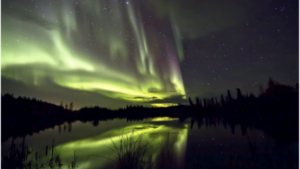Per spaceweather.com & NOAA’s Space Weather Prediction Center (SWPC):
“A high-speed stream of solar wind is approaching Earth, and NOAA forecasters say there is a 75% chance of polar geomagnetic storms when it arrives during the late hours of Dec. 4th. Periods of moderately-strong G2-class storming on Dec. 4th and 5th could send Northern Lights spilling across the Canadian border into upper-tier US states; affect shortwave radio transmissions at high latitudes; and confuse wildlife that use magnetic cues for navigation.”
The SWPC forecasts G-2 conditions starting at 2100 UT on 04 Dec and lasting through 06 UT on 05 Dec.
Though there is only a 1% chance of this G-2 causing a “radio blackout”, shortwave transmissions at higher latitudes will be affected.
You can subscribe to the SWPC to receive daily forecasts emailed to your INBOX at the following NOAA site:
https://pss.swpc.noaa.gov/RegistrationForm.aspx
Troy Riedel, is the author of this post and a regular contributor to the SWLing Post. Check out Troy’s YouTube Channel by clicking here.


This might be a more interesting site that interprets the space weather: spaceweathernews.com
Conditions have been *very* calm with just a typical coronal hole passing by the northern hemisphere of the sun. No Coronal Mass Ejections (CME’s), No sunspots to cause extreme high solar wind. The usual coronal holes cause a Moderate increase of solar wind and charging of the ionosphere, but nothing to cause “blackouts”. Just trying to give some balance to how to view these things. Based on their forecast, nothing much will happen in the next 48 hours except an increase in the Kp index.
Roger that, TomL. There are obviously more than just the two sites I listed. But both sites I listed also give descriptions of the classes & what to expect.
True, activity has been **very** weak. And I haven’t observed any sunpsots with telescopes in a while.
My main point of the post is to inform those who are unaware that space weather forecasts can be delivered to your INBOX – for those who are interested. And I chose that day to post this because I don’t remember anything higher than a G-1 for months (although a G-2 is also classified as “Minor” and nothing much was expected or encountered).
And just like terrestrial forecasts … those forecasts that say “expect rain during your AFTN commute”, space weather forecasts are no different (just because a “storm” or increase in activity is expected, that doesn’t necessarily mean it will happen). The best judge [verification] – just like rain hitting your windshield during the AFTN commute – is for SWL’ers/hams to listen in, and for amateur astronomers like myself I check the aurora activity.
Troy
Thanks for the heads-up, Troy!